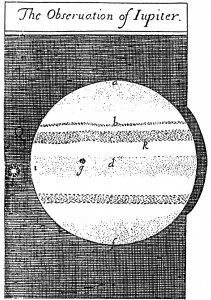Gutenberg Gems: Philosophical Transactions Vol. I.
 I was scanning through the recent additions to Project Gutenberg, and found that Volume I of the Philosophical Transactions of the Royal Society, dating back to 1666 had been converted and uploaded. It’s got a lot of interesting stuff in it (as well as some uninteresting) but the thing which caught my eye was this description of some observations of Jupiter done by Hook using a sixty foot(!) telescope. In 1666, the achromatic telescope had not been invented, and telescopes had very small aperature and very long focal lengths to avoid chromatic aberration. Yet using these telescope, Hook wrote very clearly about shadow transits crossing the surface of Jupiter. Worth checking out.
I was scanning through the recent additions to Project Gutenberg, and found that Volume I of the Philosophical Transactions of the Royal Society, dating back to 1666 had been converted and uploaded. It’s got a lot of interesting stuff in it (as well as some uninteresting) but the thing which caught my eye was this description of some observations of Jupiter done by Hook using a sixty foot(!) telescope. In 1666, the achromatic telescope had not been invented, and telescopes had very small aperature and very long focal lengths to avoid chromatic aberration. Yet using these telescope, Hook wrote very clearly about shadow transits crossing the surface of Jupiter. Worth checking out.
Philosophical Transactions Vol. I.
Some Observations lately made at London concerning the Planet Jupiter.
These, as they were made, so they were imparted, by Mr. Hook, as follows:
Sch. III.A. 1666, June 26. between 3. and 4. of the Clock in the morning, I observed the Body of Jupiter through a 60 foot-glass, and found the apparent Diameter of it through the Tube, to be somewhat more than 2. degrees, that is, about four {246}times as big, as the Diameter of the Moon appears to the naked Eye. I saw the Limb pretty round, and very well defin’d without radiation. The parts of the Phasis of it had various degrees of Light. About a and f, the North and South poles of it (in the Fig Q.) ’twas somewhat darker, and by degrees it grew brighter towards b. and e, two Belts or Zones; the one of which (b) was a small dark Belt crossing the Body Southward; Adjoyning to which was a smal Line of a somewhat lighter part; and below that again, Southwards, was the great black Belt c. Between that, and e, the other smaller black Belt, was a pretty large and bright Zone; but the middle d, was somewhat darker than the edges. I perceiv’d about 3h. 15m. near the middle of this, a very dark round Spot, like that represented at g, which was not to be perceiv’d about half an hour before: And I observed it, in about 10. minutes time to be gotten almost to d, keeping equal distance from the Satelles h, which moved also Westwardly, and was joyn’d to the Disk at i, at 3h. 25m. After which, the Air growing very hazy, and (as appeared by the Baroscope) very light also (in weight) I could not observe it: So that it was sufficiently evident, that this black Spot was nothing else, save the shadow of the Satelles h, Eclipsing a part of the Face of Jupiter. About two hours before, I had observed a large darker spot in the bigger Belt about k, which in about an hour or little more (for I did not exactly observe the time, nor draw the Figure of it) moving Westwards, disappear’d. About a week before, I discover’d also, together with a Spot in the Belt c, another Spot in the Belt e, which kept the same way and velocity with that of the Belt c. The other three Satellites in the time of this Eclipse, made by the Satelles, were Westwards of the Body of Jupiter; appearing as bright through the Tube, as the Body of Jupiter did to the naked Eye, and I was able to see them longer through the Tube, after the day-light came on, than I was able to see the Body of Jupiter with my naked eye.
I recall burning three or four weeks of a sabbatical getting Saccade.com on the air with Wordpress. So much tweaking…